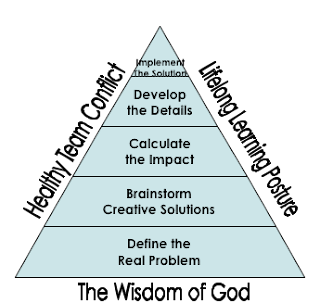Your organization, like every organization, deals with problems…daily. So how do you solve those problems? Most leaders are doers–activators by nature–who would just as soon eliminate the problem as quickly as possible. While that works some times, perhaps many times, it can also produce more problems.
So how can leaders tackle problems in a systematic and strategic way? Let me present the “problem-solving pyramid” as a means to tackle problems in your church or organization. The pyramid include five stages and is surrounded by three values (as illustrated below).
Let’s start with the five stages:
Stage 1: Define the Real Problem – Symptoms are rampant in organizations and unfortunately leaders too often deal with the symptoms without drilling down to the root cause. Figure out what’s causing the symptoms…that’s your real problem. That may take a combination of quantitative and qualitative research. One of the biggest problem producers just might be your own assumptions…Challenge assumptions.
Stage 2: Brainstorm Creative Solutions – This shouldn’t be a solo job. Bring your team into the brainstorming process. Give them permission to question, push back, recommend, and dream. Above all, shut your mouth. Leaders who do all the talking in brainstorming meetings are pouring cold water on creativity with every word they speak. Be secure. Shut up. Welcome feedback. One of the best ways to stimulate the brainstorming process is to ask questions that you, as the leader, truly do not have answers to. That will keep you from coming to the meeting with preconceived solutions.
Stage 3: Calculate the Impact – This is often the hidden stage of problem-solving. Leaders identify a symptom (sometimes even a problem), brainstorm a zillion ways to solve it, and then boom…pull the trigger. There’s one problem. They don’t stop to ask one very crucial question: “How will this solution impact the rest of the organization?” Every solution has the potential to do two things: Solve the problem and create another problem (or problems). Calculate the impact your solution will have on other employees and departments.
Stage 4: Develop the Details – Problem-solving is a thorough, detailed, process. Problem-solving without the details doesn’t solve problem–it creates problems. If you’re a visionary leader, be sure to surround yourself with strategists and administrative help to tend to the details.
Stage 5: Implement the Solution – This is where the rubber meets the road. Pull the trigger.
These problem-solving stages are relatively basic–which by no means undermines their importance. But if the stages are going to deliver remarkable results, they must be wrapped tightly in three essential values. These values are reflected on the three sides of the pyramid in the diagram above.
Value 1: The Wisdom of God – The word used for “wisdom” in the Bible is the same word used for skill or ability. God is the master architect–the One who designed how people should live. We are nothing more than builders who skillfully “live life” according to God’s design. The same principle applies on an organizational level. As we work diligently to solve problems in our churches, businesses, and organizations, it requires skill–wisdom–to solve problems according to God’s design (not our own man-made ideas).
Value 2: Healthy Team Conflict – Author Patrick Lencioni suggests that teams who have an absence of trust will experience a fear of conflict. That fear of conflict ultimately produces a lack of commitment, an avoidance of accountability, and inattention to results. Leaders must cultivate an environment of trust that allows employees to engage in productive, healthy, respectful conflict. Healthy team conflict is what allows the team to drill down to the real problem (not just symptoms) and to be honest about the impact of potential solutions.
Value 3: Lifelong Learning Posture – The final value of creative problem-solving is an attitude–a posture–of lifelong learning. When the team is personally and collectively committed to personal growth, it provides ammo for effective problem solving. Teams that don’t grow are limited to a very shallow problem-solving pool. Lifelong learning, especially when combined with healthy team conflict, leads the team to the best (and the right) solutions.
How do you solve problems in your organization? Which stage is missing in your process? Are the three values surrounding your problem-solving efforts? As you embrace these stages and values, you’ll find the most meaningful solutions to your toughest problems.







